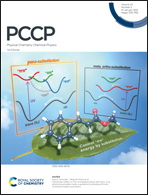Radical abstraction vs. oxidative addition mechanisms for the activation of the S–H, O–H, and C–H bonds using early transition metal oxides†
Abstract
Quantum chemical calculations are performed to study the S–H, O–H, and C–H bond activation of H2S, H2O, and CH4 by bare and ligated ZrO+ and NbO+ units. These representative oxides bear low energy oxo and higher energy oxyl units. S–H and C–H bonds are readily activated by metal oxyl states (radical mechanism), but the O–H bond is harder to activate with either the oxyl or oxo states. Our results suggest that known practices for the C–H bond activation can be applied to S–H, but not to O–H bonds. The identified trends are rationalized in terms of the HS–H, HO–H, and H3C–H dissociation energies to the homolytic or heterolytic fragments. We also found that these dissociation energies drop to about half after coordination of H2S or H2O to the metal oxide unit. In addition, chlorine ligands are shown to stabilize the higher energy oxyl states of the transition metal oxygen unit enhancing the reactivity of the formed complexes.



 Please wait while we load your content...
Please wait while we load your content...